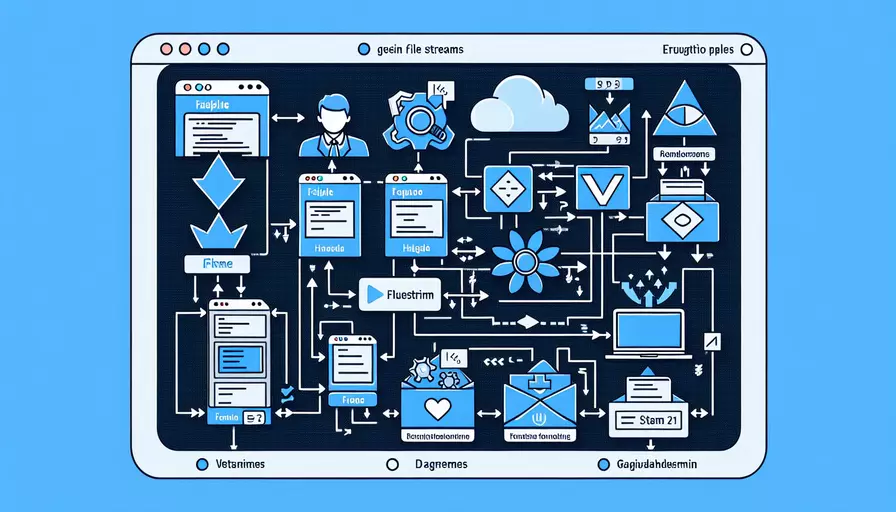
Vue接收文件流的方式主要有以下几种:1、通过表单上传;2、通过拖拽上传;3、通过API请求。下面将详细描述这些方法,帮助开发者更好地实现文件流的接收和处理。
一、通过表单上传
通过表单上传文件是最常见的方式。用户可以选择文件,提交表单后,文件流将被发送到服务器端进行处理。以下是具体步骤:
- 创建HTML表单:
<form @submit.prevent="uploadFile">
<input type="file" @change="handleFileUpload" />
<button type="submit">上传</button>
</form>
- 在Vue组件中定义方法:
export default {
data() {
return {
file: null,
};
},
methods: {
handleFileUpload(event) {
this.file = event.target.files[0];
},
uploadFile() {
let formData = new FormData();
formData.append('file', this.file);
// 使用Axios发送POST请求
axios.post('/upload', formData, {
headers: {
'Content-Type': 'multipart/form-data',
},
})
.then(response => {
console.log('文件上传成功', response.data);
})
.catch(error => {
console.error('文件上传失败', error);
});
},
},
};
二、通过拖拽上传
拖拽上传文件提供了更直观和便捷的用户体验。以下是实现步骤:
- 创建拖拽区域:
<div
@dragover.prevent
@drop.prevent="handleFileDrop"
style="border: 2px dashed #ccc; padding: 20px; text-align: center;">
拖拽文件到此区域上传
</div>
- 在Vue组件中定义方法:
export default {
data() {
return {
file: null,
};
},
methods: {
handleFileDrop(event) {
this.file = event.dataTransfer.files[0];
this.uploadFile();
},
uploadFile() {
let formData = new FormData();
formData.append('file', this.file);
// 使用Axios发送POST请求
axios.post('/upload', formData, {
headers: {
'Content-Type': 'multipart/form-data',
},
})
.then(response => {
console.log('文件上传成功', response.data);
})
.catch(error => {
console.error('文件上传失败', error);
});
},
},
};
三、通过API请求
有时文件流可能来自于API请求,需要在Vue中处理。以下步骤展示如何接收和处理文件流:
- 发送请求获取文件流:
export default {
data() {
return {
fileBlob: null,
};
},
mounted() {
this.fetchFile();
},
methods: {
fetchFile() {
axios.get('/file-download', { responseType: 'blob' })
.then(response => {
this.fileBlob = response.data;
this.downloadFile();
})
.catch(error => {
console.error('文件获取失败', error);
});
},
downloadFile() {
const url = window.URL.createObjectURL(new Blob([this.fileBlob]));
const link = document.createElement('a');
link.href = url;
link.setAttribute('download', 'filename.pdf'); // 设置文件名
document.body.appendChild(link);
link.click();
link.remove();
},
},
};
总结
通过以上三种方式,Vue可以灵活地接收和处理文件流:
- 表单上传:适用于常规文件上传操作,简单易用。
- 拖拽上传:提升用户体验,直观便捷。
- API请求:适用于从服务器获取文件流并进行处理的场景。
开发者可以根据具体需求选择合适的方式来实现文件流的接收。同时,确保在实际应用中处理文件流时,注意数据安全和用户体验,必要时进行相应的优化和调整。
相关问答FAQs:
问题1:Vue如何接收文件流?
Vue是一款流行的JavaScript框架,用于构建用户界面。在Vue中接收文件流需要通过一些特定的方法和技术来实现。下面是一种常见的方法:
- 在Vue组件中添加一个文件选择输入框,用于让用户选择文件。
<template>
<div>
<input type="file" @change="handleFileChange">
</div>
</template>
- 在Vue组件的
methods中添加一个处理文件变化的方法。
methods: {
handleFileChange(event) {
const file = event.target.files[0];
// 处理文件流
this.processFile(file);
},
processFile(file) {
// 在这里可以使用FileReader对象来读取文件流
const reader = new FileReader();
reader.onload = (event) => {
const fileData = event.target.result;
// 处理文件数据
this.handleFileData(fileData);
};
reader.readAsDataURL(file);
},
handleFileData(fileData) {
// 在这里可以对文件数据进行进一步处理,比如上传到服务器等操作
console.log(fileData);
}
}
在上述代码中,handleFileChange方法会在文件选择输入框的值发生变化时被触发,然后调用processFile方法来读取文件流。processFile方法使用FileReader对象将文件流读取为数据URL,并将其传递给handleFileData方法进行进一步处理。
这只是一种基本的方法,你还可以根据具体需求进行修改和扩展。
问题2:Vue如何在上传文件时显示进度条?
在Vue中,你可以使用一些第三方库来实现文件上传时显示进度条的功能。下面是一种常见的方法:
- 在Vue项目中安装一个适合的文件上传库,比如
axios。
npm install axios --save
- 在Vue组件中添加一个文件选择输入框和一个上传按钮,并绑定相应的事件和方法。
<template>
<div>
<input type="file" @change="handleFileChange">
<button @click="uploadFile">上传</button>
<div v-if="uploadProgress !== null">
<progress :value="uploadProgress" max="100"></progress>
</div>
</div>
</template>
- 在Vue组件的
data中添加一个uploadProgress属性,用于保存上传进度。
data() {
return {
uploadProgress: null
};
},
- 在Vue组件的
methods中添加处理文件变化和上传文件的方法。
methods: {
handleFileChange(event) {
this.file = event.target.files[0];
},
uploadFile() {
const formData = new FormData();
formData.append('file', this.file);
axios.post('/upload', formData, {
onUploadProgress: (progressEvent) => {
this.uploadProgress = Math.round((progressEvent.loaded * 100) / progressEvent.total);
}
}).then((response) => {
console.log(response.data);
}).catch((error) => {
console.error(error);
});
}
}
在上述代码中,handleFileChange方法会在文件选择输入框的值发生变化时被触发,然后将选中的文件保存在file属性中。uploadFile方法会将文件通过axios库发送到服务器,并通过onUploadProgress回调函数获取上传进度。
通过以上步骤,你就可以在上传文件时显示进度条了。
问题3:Vue如何下载文件?
在Vue中下载文件可以通过创建一个链接,然后模拟点击该链接来实现。下面是一种常见的方法:
- 在Vue组件中添加一个用于下载的按钮,并绑定相应的事件和方法。
<template>
<div>
<button @click="downloadFile">下载文件</button>
</div>
</template>
- 在Vue组件的
methods中添加处理下载文件的方法。
methods: {
downloadFile() {
const fileUrl = '/path/to/file.pdf'; // 文件的URL
const link = document.createElement('a');
link.href = fileUrl;
link.download = 'file.pdf'; // 下载文件的文件名
link.target = '_blank'; // 在新窗口中打开链接
link.click();
}
}
在上述代码中,downloadFile方法会创建一个<a>标签,并设置其href属性为文件的URL,download属性为下载文件的文件名,target属性为_blank以在新窗口中打开链接。最后通过link.click()模拟点击链接来下载文件。
以上方法适用于下载任何类型的文件,你只需要将fileUrl和link.download属性设置为你要下载的文件的URL和文件名即可。
以上是关于Vue如何接收文件流的一些常见问题的解答。希望对你有所帮助!
文章标题:Vue如何接收文件流,发布者:worktile,转载请注明出处:https://worktile.com/kb/p/3638521

 微信扫一扫
微信扫一扫  支付宝扫一扫
支付宝扫一扫 